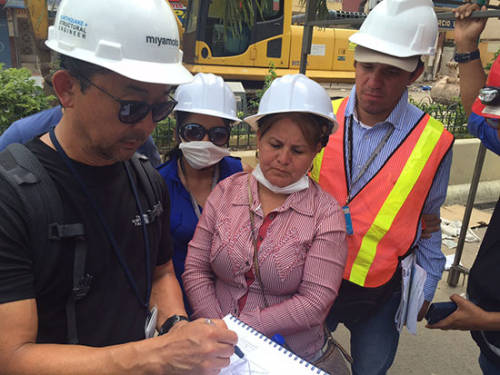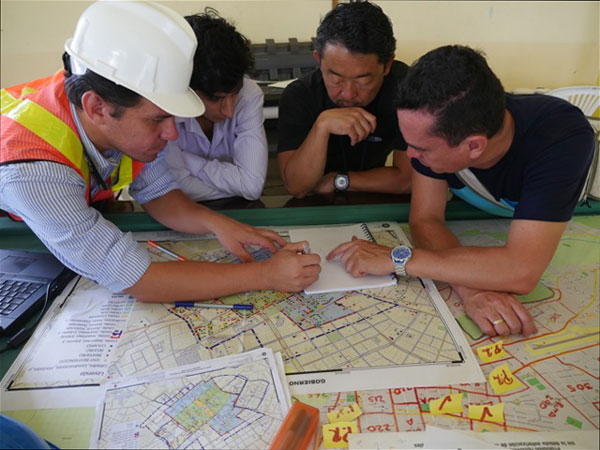8:15 a.m., April 26, 2016
As the equatorial sun beats down on us, we drive quickly to the Command Center in Portoviejo, Ecuador, Ground Zero. We are little a late by 30 minutes, Latin America Standard Time. The young planning director we met yesterday is here, working hard already. Papers are scattered everywhere. It looks like a whole crew spent the night here. Disasters are always like that, everyone works around the clock, 7 days-a-week, pay or no pay. We are all motivated by a bigger mission: save lives, build back the community.
As soon as he spots us, he spreads out a large map and we start working. A detailed damage assessment map and aerial maps from the drone we saw flying over us drape over the table. The buildings are marked in green (inspected), yellow (damaged, limited entry), red (dangerously damaged, do not enter) and black for the collapsed buildings.
I pick three blocks and explain that our goal is to help them build capacity. He looks at me puzzled. “It doesn’t make sense for foreigners to do it alone,” I explain. “We don’t stay indefinitely. You can make a long-lasting impact.” He really likes this idea.
I tell the second young man, a structural engineer assigned to oversee this process, that “this initially seems tedious, but it’s very important. Eliminating the large, 40-block Red Zone and creating “smaller, more targeted Red Zones around dangerous buildings, and the affected buildings around them, will open the city and really facilitate redevelopment.” He begins to nod. “Your work is so critical,” I say, looking into his serious brown eyes. “The city’s future is in your hands. If you fail, the city fails. If you do right, you’re going to be a hero.”
“If you do it right,
you’re going to be a hero.”
We all laugh and his mouth slowly spreads into a confident smile. We spend an hour or so going over the strategic details and then leave for the field.

As we step through the barricades for the second time in two days, the shadow of the Leaning Tower of Death looms over us. Together, we assess two blocks of buildings so they can see the process firsthand — so they can teach others. This is what we do. Share the information and have locals to take it from there.
1:20 p.m.
One of the key buildings they want us to assess is the Centro Municipal Commercial, a popular downtown market. Taking up an entire square block, it includes a large department store on one floor, small, subterranean stalls of independent vendors below it and an eight-floor office building. A large section of the market has been reduced to a mangled mass of twisted steel and rebar and broken concrete floors. We circle it, looking at the damage. It’s horrific.

A small, determined woman emerges in a perfectly ironed pink dress topped and big construction boots. She’s a chief administrator from the municipal government charged with looking out for the interests of the shop owners. People are very upset and worried, she tells us. “There are more than 180 vendors. They can’t get their goods yet, they owe the bank. They are not rich people. This is their livelihood.”

Our team enters the mammoth building, ducking under twisted metal and crunching through glass and plaster on the stairways. The older part is eight stories high. In the so-called new addition, we pass through a department store section of kids clothes in pristine condition. One step beyond that everything has fallen off the edge. I’ve been to disasters many times, but this one makes me nervous. At this point, I stopped the team and sent them out. I want to keep the risk of this evaluation to an absolute minimum. Now it’s just structural engineer Juan Sandoval, a local young guy who manages the building, and me.
We go through the rest of the building to determine whether it’s safe or not for shopkeepers to collect their merchandise. Their livelihood depends on it. We move through darkened hallways rapidly. Every minute you’re in the building, the chance of collapse increases. Merchandise hangs everywhere in eerie, abandoned stores.
2:35 p.m.
Outside, I meet the construction booted lady again. I say, “The good news is, the tower seems okay. The bad news is, certain areas of the market should be closed to passage. No one should enter.” The administrator representing the vendors is visibly upset. I tell her: “I did the best I can to define the risk for you. Now, it is important to plan out the limited entry to retrieve assets by small groups. But engineers must accompany them at all times. “She smiles and says “Muchas, muchas gracias.”
5:30 p.m.
As we drive back to our jungle hotel, I think about the risks I take in these half-collapsed buildings. They may be old, gray, concrete architectural disasters, but for someone, these homes and buildings are their world; the special place they inhabit or own. It is their livelihood, a place to live; it is where their kids are born or learn. That’s why I do this.
My thoughts float back to my wife, Sabine. We just got married a couple weeks ago, but I had to leave her in L.A. to come here. I think about her tenderness when I hold her hand. I think about my kids and their laughs. I miss them. I love to be here, but I hate to be here.

